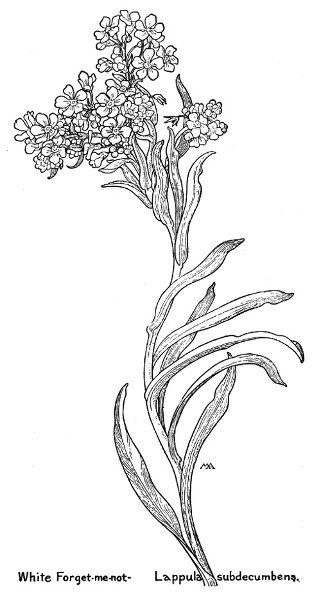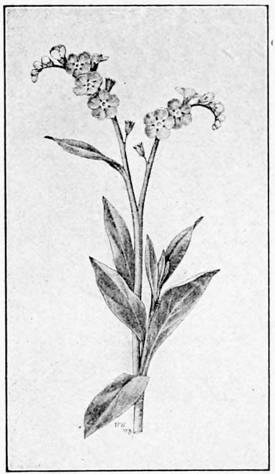Flowers bloom as the snow melts and the temperatures warm. Among the most unforgettable flowers is the Myosotis, colloquially known as the forget-me-nots (pun intended). In this article, I will look at two accounts of how the forget-me-not flower earned its name. The first account is from a poem by an “E. Ridley” reprinted in the March 11, 1899 issue of “The Girl’s Own Paper.” Ridley offers a beautiful allegorical origin story for the name forget-me-not. The second, courtesy of Dana Wells’ “100 Flowers and How They Got Their Names,” is the true story of the name “forget-me-not.” I will supplement Ms. Wells’ text with additional information about the name and its back story.
The accounts are fittingly memorable.

Note: Final section of the article added on October 29, 2021. All content above the final section was published on March 11, 2021.
The Poetic Account of the Forget-Me-Not’s Name
The Girl’s Own Paper had an “open letter box” for reader submissions. The editors solicited submissions for verses. An anonymous submitter who went by “Nell” submitted a poem called “The Forget-Me-Not.” In the March 11, 1899 issue in which the poem appeared, the author is listed as “E. Ridley.” After some searching, I discovered on the site of a Welsh library that the full name of the author is “Ethel Ridley.” I could not find any specific information about Ethel Ridley – but her poem gives a strong account of her absent a formal biography.
Below, you will find “The Forget-Me-Not” reprinted verbatim from The Girl’s Own Paper, which in turn reprinted the poem verbatim from “Nell’s” letter.
“The Forget-Me-Not” by Ethel Ridley
It's said that ages, long ago, when God had formed the earth and heaven, He called the flowers one by one, until to all sweet names He'd given: To one, pure Lily, other Rose, another Violet, or Daisy fair, As each bright flower before Him passed, to wear anew its Father's care. But oh! one day a tiny flower, with pale blue eye and little tear, Came back to Him and said, "Dear Lord, I've forgotten quite my name, I fear." Then looking down upon the flower, which trembling stood, with bended head, Without reproof or look unkind, "Forget-Me-Not," he gently said.
My Thoughts on “The Forget-Me-Not” by Ethel Ridley
As soon as I read “The Forget-Me-Not,” I knew that I had to share it with New Leaf Journal readers. Ridley was able to tie the little flower’s appearance into the poem in a memorable way “- “a tiny flower, with pale blue eye and little tear.” The conclusion serves as a lovely lesson for remembering that which is most important.
The True Story of How the Forget-Me-Not Got Its Name
Dana Wells wrote about the names of 100 flowers in her book 100 Flowers and How They Got Their Names. According to Ms. Wells, “[t]he name ‘forget-me-not’ comes from the old French ne m’oubliez mye, which in turn was a translation of the German vergiss mein nicht.”
Source: Wells, Diana. "100 Flowers And How They Got Their Names." Algonquin Books of Chapel Hill. 1997. Kindle. (Loc. 849-866).
I know neither old French nor German, but I know enough about aesthetics to opine that the former is a better source for flower names.
Citing to a different author, Wikipedia notes that the forget-me-not name first made it into English in 1398.

The German Legend Behind the Forget-Me-Not Flower Name
The 1911 edition of Encyclopedia Britannica added background history – which was also noted by Ms. Wells: “The forget-me-not, a favourite with poets, and the symbol of constancy, is a frequent ornament of brooks, rivers, and ditches, and, according to an old German tradition, received its name from the last words of a knight who was drowned in the attempt to procure the flower for his lady.”
Leopold Wagner told the story of the forget-me-not in this nineteenth century text – Names: And Their Meaning:
The name of Forget-me-not originated in the following legend:—A German knight and his lady were walking on the bank of the Danube, when the fair one saw a beautiful tuft of Myosotis palustris growing in the water, and expressed a wish to have it. With chivalrous alacrity the knight at once plunged into the river and gathered his prize; but before he could regain the steep and slippery bank, encumbered as he was by his heavy armour, he was drawn by the treacherous eddy into a deep pool. Finding he could not save himself, he threw the flowers ashore to his mistress as he sank, and uttered with his last breath the words “Vergess mein nicht!” (“Forget-me-not!”) Hence this flower has come to be universally regarded as the emblem of fidelity.
Leopold Wagner (Names: And Their Meaning)
The Language of the Forget-Me-Not
Kate Greenaway opined in The Language of Flowers that the language of the forget-me-not flower is “true love.”
The Meaning of “Myosotis”
Having covered the name “forget-me-not,” we may as well examine the flower’s other name, “myostis.” Here, the 1911 Encyclopedia Britannica explained the manner succinctly: Myostis comes “from the Greek μῦς, a mouse, and οὖς, an ear, on account of the shape of the leaves.”

Revisiting Forget-Me-Not Valley
The first time I recall encountering the name “forget-me-not” was not with reference to the flower. In 2004, a Nintendo GameCube video game by the name of Harvest Moon: A Wonderful Life, made it to the United States after having been released in Japan in late 2003. Like other entries in the Harvest Moon series, A Wonderful Life focused on farm life. It is one of the more unique entries in the series in that it focuses on marriage and raising a child. It is also the darkest Harvest Moon, despite its optimistic name. But all that is a digression. I note it here because the entire slow-paced adventure takes place in Forget-Me-Not Valley. I remembered that off the top of my head despite not having visited Forget-Me-Not Valley in a long while.
Lesson learned. The name works.
Another Forget-Me-Not Game
Section Added on October 29, 2021.
On October 29, 2021, I reviewed a freeware doujin horror visual novel titled Night of the Forget-Me-Nots. For spoiler-avoidance purposes, I did not go into the plot of the game in detail. However, I can spoil that the inclusion of “forget-me-not” in the title does in fact reference the flower, and the reference plays a role in the game itself. The flower motif is clear from the title screen, which features the forget-me-not flower in its design.
I conclude this late addition to my forget-me-not article with an additional note. The original title of the game in Japanese (romanticized) is Wasurenagusa no Yoru. My understanding is that “wasurenagusa” – written as “ワスレナグサ” in Kanji – translates to “forget me not.”